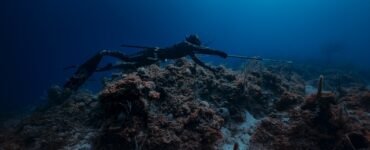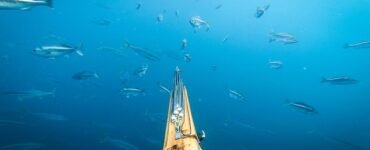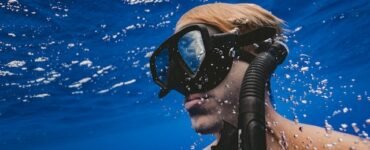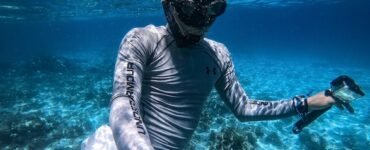Spearfishing is an exciting and rewarding activity that requires a combination of skill knowledge and safety awareness. Whether you’re a beginner or an experienced spearfisher prioritizing safety should always be at the forefront of your diving practices. In this article we will explore some essential diving practices to ensure a safe and enjoyable spearfishing experience.
1. Proper Equipment and Gear
Using the appropriate equipment and gear is crucial for safe spearfishing. Here are some key considerations:
- Speargun Safety: Familiarize yourself with the operation and safety features of your speargun. Ensure the safety is engaged when not in use and handle the speargun responsibly at all times.
- Wetsuit and Weight Belt: Wear a properly fitting wetsuit that provides thermal protection and freedom of movement. Use a weight belt adjusted to achieve neutral buoyancy allowing you to descend and ascend comfortably.
- Mask Snorkel and Fins: Use a high-quality mask that provides a clear field of vision and ensures a proper seal. Select a snorkel that facilitates efficient breathing on the surface. Opt for fins that are comfortable and suitable for the diving conditions.
Regularly inspect your gear for any signs of wear or damage and replace or repair as necessary.
2. Buddy System
The buddy system is a fundamental safety practice in spearfishing. Always dive with a reliable dive buddy or in a group. Here’s why the buddy system is important:
- Safety Support: A dive buddy can provide assistance in case of emergencies equipment malfunctions or unexpected situations underwater.
- Shared Knowledge and Experience: Diving with a buddy allows for knowledge sharing learning from each other’s experiences and improving diving skills together.
- Increased Awareness: Two sets of eyes are better than one. A dive buddy can help spot potential hazards monitor each other’s well-being and enhance overall situational awareness.
Before diving establish clear communication signals and develop a plan for emergencies or unexpected scenarios. Regularly check in with your buddy throughout the dive.
3. Dive Planning and Pre-Dive Checks
Proper dive planning and pre-dive checks are essential to minimize risks and ensure a safe diving experience. Consider the following practices:
- Research Dive Locations: Familiarize yourself with the dive site including potential hazards currents and depth. Consult local diving resources and gather information from experienced divers in the area.
- Weather and Conditions: Check weather forecasts and sea conditions before diving. Avoid diving in unfavorable conditions such as strong winds storms or poor visibility caused by heavy rainfall.
- Equipment Checks: Conduct thorough pre-dive equipment checks to ensure everything is in proper working condition. Check the condition of your gear including the speargun mask snorkel fins and any additional equipment.
- Equalization and Breathing Exercises: Practice equalization techniques to equalize pressure in your ears and sinuses as you descend. Perform breathing exercises to relax and prepare your body for the dive.
By incorporating these practices into your routine you can enhance safety and preparedness before each dive.
4. Dive within Your Limits
Knowing and respecting your limits is crucial for safe spearfishing. Consider the following:
- Experience and Skill Level: Be honest with yourself about your experience and skill level. Gradually progress to more challenging dives as you gain experience and confidence.
- Depth and Bottom Time: Set depth limits based on your training and comfort level. Monitor your bottom time to avoid excessive fatigue and the risk of decompression sickness.
- Physical and Mental Readiness: Ensure you are physically and mentally prepared for each dive. Get enough rest stay hydrated and avoid diving under the influence of alcohol or drugs.
Remember it’s better to dive conservatively and stay within your limits than to push yourself beyond what you are comfortable with.
5. Respect Marine Life and the Environment
As spearfishers it is our responsibility to respect marine life and the environment we dive in. Here’s how you can promote environmental stewardship:
- Selective Harvesting: Only target the species you intend to consume and follow local regulations regarding size and bag limits.
- Avoid Damage to Habitat: Be mindful of your surroundings and avoid damaging coral reefs seagrass beds or other fragile marine habitats.
- Proper Disposal of Trash: Dispose of any trash or waste properly and do not leave any litter behind.
Respecting marine life and the environment ensures the sustainability of the ecosystem and the enjoyment of future generations.
Conclusion
Safety should always be the top priority when engaging in spearfishing. By following proper diving practices using the right equipment diving with a buddy planning dives and respecting your limits and the environment you can minimize risks and ensure a safe and enjoyable spearfishing experience. Remember to stay informed continuously improve your skills and make safety a habit every time you dive.
FAQs
1. Can I spearfish alone?
While it is possible to spearfish alone it is strongly recommended to dive with a buddy or in a group for safety reasons. A dive buddy provides assistance in case of emergencies and enhances overall situational awareness.
2. What should I do in case of an equipment malfunction underwater?
If you experience an equipment malfunction underwater signal your dive buddy immediately. Ascend to the surface together while following established emergency procedures. Maintain calm and do not attempt to fix the issue underwater.
3. How do I know if I am physically fit for spearfishing?
Physical fitness is important for spearfishing. Consult with a medical professional to ensure you are in good health and capable of handling the physical demands of diving. Regular exercise including cardio and strength training can improve your overall fitness for diving.
4. Are there any regulations or restrictions on spearfishing?
Yes spearfishing regulations and restrictions vary by location. Familiarize yourself with local fishing regulations including size limits bag limits and protected species. Adhere to these regulations to promote sustainable fishing practices.
5. What can I do to contribute to marine conservation?
You can contribute to marine conservation by practicing selective harvesting avoiding damage to marine habitats and properly disposing of trash. Support local conservation initiatives and participate in beach and underwater clean-up activities when possible.

Explore the mesmerizing world of spearfishing on our blog! Discover tips, techniques, and breathtaking underwater stories from passionate spearfishers. Dive in for an ocean of adventure.







